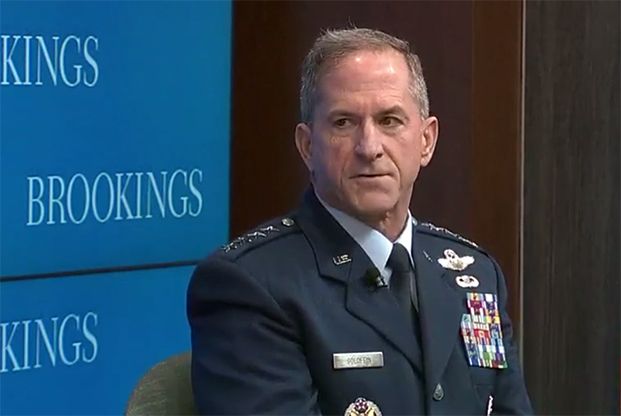
CAPTION: Air Force Chief of Staff Gen. David Goldfein speaks at a Brookings Institution event in Washington on Feb. 19, 2019. C-SPAN screenshot.
The budget the Trump Administration will present to Congress in a few weeks begins to move the Air Force toward a force structure level that will meet the requirements of the National Defense Strategy, service Chief of Staff Gen. David Goldfein said at the Brookings Institution in Washington, D.C., Tuesday.
The investments requested will achieve a force able to carry out the NDS with a “moderate” level of risk in the 2025-2030 timeframe, and the budget will include $135 billion across the “joint team” for “penetration” projects aimed at defeating enemy anti-access capabilities.
The Air Force’s topline budget amount—which he did not reveal—is the result of “3,000 iterations” of various force structure “combinations,” Goldfein said, acknowledging that those iterations, and the timeline upon which national goals could be met with the force requested, will remain classified to all but cleared Capitol Hill members and staff.
“This is not a gold-plated force,” he insisted, but a “fully burdened” force capable of addressing all five tenets of the NDS. Those tenants include, defending the homeland; providing a “safe, secure, and effective” nuclear deterrent; the ability to defeat a “peer threat,” such as Russia or China, while deterring a “rogue nation,” such as North Korea, and maintaining “momentum against violent extremists.”
He noted that the new force structure levels—spelled out last September in “The Air Force We Need” white paper—will, for the first time in a long time, be structured against actual requirements, rather than built against expected affordability.
The 386 combat squadrons the service said it needs compares frugally with the 401 combat squadrons USAF fielded in 1990, when it went to war in the Middle East, he said, adding that the military services are not, with this budget, “playing the game of … asking for more and settling for less.”
“Congress will be able to see the fidelity of the analysis” leading to the numbers the Air Force articulated for bombers, fighters, tankers, etc. There will be an emphasis on bombers, tankers, and long-range intelligence, surveillance, and reconnaissance capabilities because of the distances involved in a potential fight with China or Russia, he noted.
In questioning after his remarks, Goldfein acknowledged the strategy calls for defeating just one peer adversary—China or Russia—while holding an adventurous second-tier power at bay. The most recent previous iterations of national strategy have called for defeating a major adversary while fighting a holding action against a second.
The commission that evaluated the NDS last fall asserted that no matter what the scenario, the Air Force is the “critical” force necessary for success, Goldfein asserted.
He praised Congress for its fiscal 2018 and 2019 budgets, which he said arrested and have “begun to reverse” a long slide into unreadiness. The key thing the service needs now to rebuild its forces and achieve optimum readiness is a “predictability” of budgets, Goldfein said, adding that endless continuing resolutions, and especially sequestration, have robbed the service of the ability to be effective and efficient in its planning and spending.
Goldfein observed that he is building the force that the Chief of Staff in the 2030 timeframe will be able to present to future combatant commanders, whereas he is able to present forces based on the investments of former chiefs, Gens. John Jumper and Mike Ryan. “It takes time” to build a rational Air Force that is capable against the full spectrum of requirements, he said.
Goldfein went out of his way to mention the F-35 in his remarks, several times referring to it as the indispensable “quarterback” of an air campaign, able to “call audibles in real time,” which no other aircraft can do from inside enemy airspace. Should an enemy actually see an F-35, it will only serve to put him on notice that “we’re here” as a joint force, able to go where it wants to go, “and there’s nothing you can do about it,” Goldfein said.
The F-35 is the connective tissue of the future battle force, he added, gathering up and exploiting information constantly. He quoted the Chief of Staff of the Israeli Air Force as saying it’s not that the F-35 is being integrated into the Israeli Defense Forces, but that “’we’re integrating the Israeli Defense Forces into the F-35.’”
The F-35 is “meeting or exceeding our expectations,” he said, dismissing deficiencies with the gun on the F-35A, recently reported by the Director of Operational Test and Evaluation, as not having an effect on the aircraft’s deployment or principal missions.
In other news, Goldfein said that while the Air Force’s Air Combat Command and Army Training and Doctrine Command have been working on a new joint Multi Domain Operations doctrine that echoes the “AirLand” doctrine of the 1970s, it won’t be ready for about another year. The doctrine will seek to “use our asymmetric advantages” and cause “simultaneous dilemmas” across an adversary’s order of battle. This, he said, will have a deterrent effect on peer adversaries.
Goldfein also acknowledged “the nation needs 4,500 pilots a year for the next 10 years,” and the service is working with industry and other agencies to inspire the next generation of pilots to take up the profession. Some of that will be through the Civil Air Patrol, and some through the Junior ROTC program, he said, because those two organizations tend to be supplying the bulk of pilot-eligible recruits. Nationally, though, the pool of youth able to meet the intellectual and physical standards of the military is shrinking, and “everybody is fishing in the same pool,” Goldfein observed.
While the Air Force continues to meet its recruiting quotas, Goldfein said it’s getting harder. Until recently “we could ring the bell”—meaning the monthly quota is reached—“around the 16th of the month. … Now, it’s closer to the 29th.”